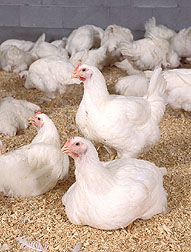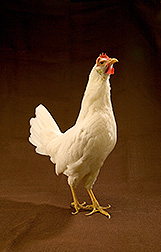|
 Avian influenza (AI) is a virus-caused disease usually infecting birds. AI viruses can infect chickens, turkeys, pheasants, quail, ducks, geese and guinea fowl as well as a wide variety of other birds, including migratory waterfowl. Avian influenza (AI) is a virus-caused disease usually infecting birds. AI viruses can infect chickens, turkeys, pheasants, quail, ducks, geese and guinea fowl as well as a wide variety of other birds, including migratory waterfowl.
AI viruses are classified by a combination of two groups of proteins: hemagglutinin proteins (H), of which there are 16 (H1-H16), and neuraminidase proteins (N), of which there are 9 (N1-N9).
AI strains are also divided into two groups based on pathogenicity—the ability of the virus to produce disease. Most AI strains are classified as low pathogenicity (LP) avian influenza and cause little or no clinical signs in infected birds. LPAI poses no serious threat to humans. Some strains of LPAI—H5 and H7—can mutate to the more highly pathogenic forms. Birds with HPAI get a more virulent form of avian influenza.
People can get HPAI from birds, but it requires extensive close contact with infected birds. For HPAI to spread from person to person, the virus would have to mutate, to change.
The strain that is currently a problem from Southeast Asia is H5N1 HPAI.
To learn more about ARS avian influenza research, see:
"International Partnership for Poultry Safety," in the November 2005 issue of Agricultural Research magazine.
"A New, Rapid Test for Avian Influenza," in the February 2003 issue of Agricultural Research magazine.
For information about other USDA programs on avian influenza, go to www.usda.gov/birdflu.
ARS Research Projects and Programs
ARS is developing new information and important tools to help control this disease in poultry. ARS supports USDA’s Animal and Plant Health Inspection Service, The Centers for Disease Control and Prevention, and poultry industry action programs with epidemiology, molecular virology, pathogenesis research, and technical assistance on avian influenza.
- In 2002, ARS developed a new rapid diagnostic test for avian influenza and has been continually improving the test’s sensitivity. This test now diagnoses avian influenza within three hours, compared with up to two weeks required for previous tests.
- Today, ARS researchers are studying factors that affect the virus’ transmission between birds and its genetic and molecular adaptation from waterfowl and other migratory birds to domestic poultry. They are also evaluating the role of ducks in Asia as an infection reservoir that might be sustaining the virus in the environment.
- ARS researchers are also working to develop enhanced vaccines for birds against avian influenza.
- ARS is developing and evaluating techniques to predict which mild forms of viruses might change to more deadly forms of the AI virus.
- ARS is assisting the Centers for Disease Control and Prevention with evaluating recombinant vaccines to ensure human vaccines will not cause disease in poultry.
- ARS is directly assisting APHIS in trade negotiations of poultry products by determining the risk for low and high pathogenicity AIV in poultry meat and the ability of pasteurization to inactivate AIV in egg products and cooking to kill HPAIV in poultry meat.
 Southeast Poultry Research Lab Avian Influenza Research Program: Southeast Poultry Research Lab Avian Influenza Research Program:
http://seprl.ars.usda.gov/avian_flu.html
The Southeast Poultry Research Lab (SEPRL) research efforts on avian influenza are directed toward understanding why and how mild viruses become highly pathogenic, developing better diagnostic tests and improved vaccines, and elucidating the molecular and pathological basis for virulence.
Research Projects
Application of Biological and Molecular Techniques to the Diagnosis and Control of Avian Influenza and Other Emerging Poultry Pathogens
http://www.ars.usda.gov/research/projects/projects.htm?ACCN_NO=411346
Development of An Experimental Model and Testing for Efficacy of West Nile and Avian Influenza Recombinant Pox Vectored Vaccines
http://www.ars.usda.gov/research/projects/projects.htm?ACCN_NO=405547
Mucosal Immunization to Protect Poultry Against Avian Influenza
http://www.ars.usda.gov/research/projects/projects.htm?ACCN_NO=405500
Prevention and Control of Avian Influenza in the U.S.
A large ($5 million) multi-location, multi-institution grant from USDA Cooperative State Research, Education and Extension Service, in which ARS is a partner.
http://www.aicap.umd.edu/
Publications
Publication Abstract: Avian Influenza Virus: Prospects for Prevention and Control by Vaccination
http://www.ars.usda.gov/research/publications/publications.htm?seq_no_115=172748
Publication Abstract: Characterization of Highly Pathogenic H5N1 Avian Influenza a Viruses Isolated from Korean Poultry
http://www.ars.usda.gov/research/publications/publications.htm?seq_no_115=168553
Publication Abstract: Comparative Susceptibility of Selected Avian and Mammalian Species to a Hong Kong-Origin H5N1 Highly Pathogenic Avian Influenza
http://www.ars.usda.gov/research/publications/publications.htm?seq_no_115=134622
Publication Abstract: Use of a Novel Virus Inactivation Method for a Multi-Center Avian Influenza Real-Time Rt-Pcr Proficiency
http://www.ars.usda.gov/research/publications/publications.htm?seq_no_115=156392
Agricultural Research magazine
"A New, Rapid Test for Avian Influenza," Feb. 2003
http://www.ars.usda.gov/is/AR/archive/feb03/avian0203.htm
For more information about ARS avian influenza programs, contact
Cyril G. Gay, National Program Leader, Animal Health
301-504-4786
|